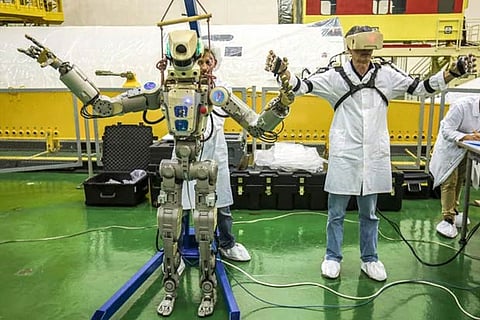

Moscow
Russia on Thursday launched an unmanned rocket carrying a life-size humanoid robot that will spend 10 days learning to assist astronauts on the International Space Station.
Named Fedor, for Final Experimental Demonstration Object Research with identification number Skybot F850, the robot is the first ever sent up by Russia.
Fedor blasted off in a Soyuz MS-14 spacecraft at 6:38 am Moscow time (0338 GMT) from Russia's Baikonur cosmodrome in Kazakhstan. The Soyuz is set to dock with the space station on Saturday and stay till September 7.
Soyuz ships are normally manned on such trips, but on Thursday no humans are travelling in order to test a new emergency rescue system.
Instead of cosmonauts, Fedor was strapped into a specially adapted pilot's seat, with a small Russian flag in his hand.
"Let's go. Let's go," the robot was heard as 'saying' during launch, apparently repeating the famous phrase by first man in space Yury Gagarin.
The silvery anthropomorphic robot stands 1.80 metres (5 foot 11 inches) tall and weighs 160 kilograms (353 pounds).
Fedor has Instagram and Twitter accounts that describe it as learning new skills such as opening a bottle of water. In the station, it will trial those manual skills in very low gravity.
"That's connecting and disconnecting electric cables, using standard items from a screwdriver and a spanner to a fire extinguisher," the Russian space agency's director for prospective programmes and science, Alexander Bloshenko, said in televised comments ahead of the launch.
"The first stage of in-flight experiments went according to the flight plan," the robot's account tweeted after reaching orbit.
Fedor copies human movements, a key skill that allows it to remotely help astronauts or even people on Earth carry out tasks while they are strapped into an exoskeleton.
Such robots will eventually carry out dangerous operations such as space walks, Bloshenko told RIA Novosti state news agency.
On the website of one of the state backers of the project, the Foundation of Advanced Research Projects, Fedor is described as potentially useful on Earth for working in high radiation environments, de-mining and tricky rescue missions.
On board, the robot will perform tasks supervised by Russian cosmonaut Alexander Skvortsov, who joined the ISS last month, and will wear an exoskeleton in a series of experiments scheduled for later this month.
Space agency chief Dmitry Rogozin showed pictures of the robot to President Vladimir Putin this month, saying it will be "an assistant to the crew".
"In the future we plan that this machine will also help us conquer deep space," he added.
Fedor is not the first robot to go into space.
In 2011, NASA sent up Robonaut 2, a humanoid robot developed with General Motors and a similar aim of working in high-risk environments.
It was flown back to Earth in 2018 after experiencing technical problems.
In 2013, Japan sent up a small robot called Kirobo along with the ISS's first Japanese space commander. Developed with Toyota, it was able to hold conversations -- albeit only in Japanese.
Visit news.dtnext.in to explore our interactive epaper!
Download the DT Next app for more exciting features!
Click here for iOS
Click here for Android